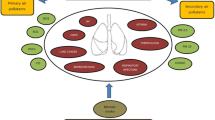Abstract
Exposure to substances found in the indoor environment is known totrigger respiratory illnesses such as asthma. Despite this knowledge,information on how to identify and remove these exposures is scarce. Toaddress this issue, we describe a program of environmental assessmentdeveloped at Children's Mercy Hospital in Kansas City, Missouri. Weevaluated buildings using a standardized assessment protocol. Thisprotocol included a combination of background information, visualinspection, volumetric air sampling, bulk sampling of suspicious areas,antigen measurement of housedust, and general measurements of the indoorclimate. We inspected a total of 63 buildings including 49 single unitstructures, 4 apartments, 4 town homes, 3 schools, 2 office buildings,and 1 mobile home. Most of these locations were identified because ofrespiratory ailments reported by the occupants. A screeningquestionnaire revealed factors that are known to be associated withfungal contamination such as leaks or flooding in 78% of thebuildings. Visual inspection confirmed these sources of contamination inthe majority of structures. Volumetric air sampling identified a highproportion of buildings with airborneAspergillus/Penicillium species. Stachybotrys wasfound in nearly 30% of these structures both in air and onsurface samples, and surprisingly, Stachybotrys spores werefound only in air in nearly 20%. Climactic factors were onlyweakly associated with fungal contamination. The homes of patients withrespiratory diseases often have significant fungal contamination thatcan be identified with a questionnaire. Using this standardizedapproach, factors associated with respiratory illnesses, usually fungalcontamination, frequently can be identified. Whether removal of theoffending exposure will lead to improve health remains to bedetermined.
Similar content being viewed by others
References
Barnes C., Schreiber K., Pacheco F., Landuyt J., Hu F. and Portnoy J.: 1999, Measurement of allergens from outdoor air. Annals of Allergy Asthma and Immunology, in Press.
Cage B., Schreiber K., Barnes C. and Portnoy J.: 1996, Evaluation of four bioaerosol samplers in the outdoor environment. Annals of Allergy Asthma and Immunology 77(1), 1–7.
Call R.S., Ward G. and Jackson S. and Platts-Mills T.A.: 1994, Investigating severe and fatal asthma. Journal of Allergy & Clinical Immunology 94(6 Pt 1), 1065–1072.
Corey J.: 1994, Environmental control of allergens. Otolaryngol Head Neck Surg (United States) 111(3 Pt 2), 340–347.
Haines J., Escamilla B., Muilenberg M., Gallup J. and Levetin E.: 1999, Mycology of the Air. AWorkshop Manual for Sampling and Identifying Airborne Fungus Spores. New York State Museum Press, Albany, NY, USA.
Cosentino S., Pisano P.L., Fadda M.E. and Palmas F.: 1990, Pollen and mold allergy: aerobiologic survey in the atmosphere of Cagliari, Italy (1986–1988). Annals of Allergy 65(5), 393–400.
Enberg R.N., Shamie S.M., McCullough J. and Ownby D.R.: 1993, Ubiquitous presence of cat allergen in cat-free buildings: probable dispersal from human clothing. Annals of Allergy 70(6), 471–474.
Fadel R., David B., Paris S. and Guesdon J.L.: 1992, Alternaria spore and mycelium sensitivity in allergic patients: in vivo and in vitro studies. Annals of Allergy 69(4), 329–335.
Frost A.: 1988, Frequency of allergy to Alternaria and Cladosporium in a specialist clinic. Allergy 43(7), 504–507.
Gelber L.E., Seltzer L.H., Bouzoukis J.K., Pollart S.M., Chapman M.D. and Platts-Mills T.A.: 1993, Sensitization and exposure to indoor allergens as risk factors for asthma among patients presenting to hospital. American Review of Respiratory Disease 147(3), 573–578.
Henderson F. and Beck M.: 1994, Levels of group I mite allergen in the himes of mite allergic children with and without asthma, In: Chang J (ed.) US Environmental Protection Agency Indoor Air Biocontaminant Research Workshop. US EPA, Raleigh, NC.
Johanning E., Landsbergls P., Garels M., Yang C. and Olmsted E.: 1999, Clinical exaprience and results of a sentinel health investigation related to indoor fungal exposure. Environmental Health Prospectives 107 (suppl 3), 489–494.
Platts-Mills T.A.: 1990, Allergens and asthma [Review]. Allergy Proceedings 11(6), 269–271.
Platts-Mills T.A., Ward G.W. Jr., Sporik R., Gelber L.E., Chapman M.D. and Heymann P.W.: 1991, Epidemiology of the relationship between exposure to indoor allergens and asthma [Review].International Archives of Allergy & Applied Immunology 94(1–4), 339–345.
Platts-Mills T.A.: 1994, How environment affects patients with allergic disease: indoor allergens and asthma [Review]. Annals of Allergy 72(4), 381–384.
Portnoy J., Brothers D., Pacheco F., Landuyt J. and Barnes C.: 1998, A double monoclonal antibody assay for the Alternaria Allergen, Alt a1. Annals of Allergy, Asthma and Immunology 81, 59–64.
Portnoy J., Pacheco F., Upadrashta B. and Barnes C.: 1993, A double monoclonal antibody-based assay for the 70Kd Alternaria allergen, GP70. Annals of Allergy 71, 401–407.
Services U.: 1990, Report of the NIAID Task Force on Immunology and Allergy. National Institutes of Health (USA) Bethesda MD.
Tarlo S.M., Franklin A. and Tobin R.S.: 1988, Skin testing with extracts of fungal species derived from the homes of allergy clinic patients in Toronto, Canada. Clinical Allergy 18(1), 45–52.
Wood S.: 1986, Review of hay fever. 1. Historical background and mechanisms. Fam Pract (England) 3(1), 54–63.
Author information
Authors and Affiliations
Rights and permissions
About this article
Cite this article
Portnoy, J.M., Flappan, S. & Barnes, C.S. A procedure for evaluation of the indoor environment. Aerobiologia 17, 43–48 (2001). https://doi.org/10.1023/A:1007636931182
Issue Date:
DOI: https://doi.org/10.1023/A:1007636931182




